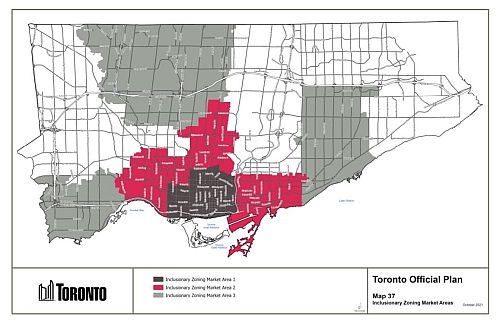Background
On November 9, 2021, Toronto City Council adopted a new Inclusionary Zoning ("IZ") policy framework in the form of an Official Plan Amendment ("OPA"), Zoning Bylaw Amendment ("ZBLA"), and draft Implementation Guidelines. Toronto is the first city in Ontario to seek Ministerial approval of an IZ framework, a process which the City essentially commenced in September 2020, when its Planning and Housing Committee endorsed the first draft of an Official Plan and Zoning Amendment and directed its planning staff to conduct further analysis, consultations and meet with key stakeholders, housing advocates and the development community. The City believes its use of Inclusionary Zoning will assist in achieving its affordable housing supply target of 40,000 affordable rental homes and 4,000 ownership homes by 2030 in accordance with the City's Housing TO Action Plan.
Inclusionary Zoning is a powerful provincial planning tool that provides municipalities with the statutory authority to mandate, for certain new developments, the inclusion of affordable rental and ownership housing and to maintain this supply for a minimum period of 99 years. Beginning on a specific date in 2022 (which remains tied to Ministerial approval of the City's IZ policy framework), the City of Toronto will be applying Inclusionary Zoning to residential projects that propose a minimum of 100 dwelling units and 8,000 sq.m of new residential gross floor area.
The City's move, which has been shaped by a multi-year consultation process, builds upon provincial requirements under the Planning Act and inclusionary zoning regulations that (1) require municipalities to have established conditions in their Official Plan to implement Inclusionary Zoning, and (2) narrows the use of Inclusionary Zoning to Protected Major Transit Station Areas ("PMTSA") or an area where a Development Permit System has been ordered by the Minister of Municipal Affairs and Housing.
Location
The City's PMTSAs are to be located within Inclusionary Zoning Market Areas ("IZMA(s)"), both of which are discussed further below.
In the adopted IZ framework, rent and ownership prices will be centered on new income-based definitions of affordable housing targeting households with an annual income of between $32,486 and $91,611. The City's framework intends for affordable housing to be located within the proposed development to support the creation of mixed-income developments in accordance with its over-arching housing policy objective of building "complete communities". However, there is flexibility in the OPA for the development of affordable units offsite from the proposed development, which is allowed by the Planning Act. These offsite units must be located where Inclusionary Zoning applies, and in proximity to the onsite market rate development.
PMTSA
PMTSAs, which will become a subset of the City's 180+ Major Transit Station Areas ("MTSA"), are delineated through detailed planning frameworks pursuant to section 16(15) of the Planning Act. The provincial Growth Plan defines MTSAs generally as areas within an approximate 500 to 800 metre radius of a transit station, representing a 10-minute walk. To satisfy the Growth Plan requirements, the City is required, pursuant to the Municipal Comprehensive Review process, to individually delineate the boundaries for all of its existing MTSAs and to demonstrate that, individually, each MTSA is planned to achieve the provincially established minimum density target.
In reviewing its MTSAs and where Inclusionary Zoning might be appropriate, the City has approved two PMTSAs — Finch West Transit Station Area and Sentinel Transit Station Area. And, City staff have identified another 16 PMTSAs in the downtown area for consultation based on the Downtown Secondary Plan. City staff intend to bring forward the remaining PMTSAs where Inclusionary Zoning would apply — in the form of an OPA that identifies the additional PMTSA boundaries — for Ministerial approval in the first quarter of 2022, before the Province's July 1st deadline for Growth Plan conformity.
IZMA
The City has proposed three Inclusionary Zoning Market Areas in the OPA and ZBLA. These areas, identified on the City's OPA Map 37 below, were determined through a review of a number of indicators, including resale prices for condominium apartments, resale price escalation, new condominium prices, new condominium price escalation, new rental prices, intensity of development activity measured by the number of approved and proposed units in the development pipeline, and the results of a financial viability analysis prepared by N. Barry Lyon Consultants Limited, who conducted a residual land value assessment of the impact of a range of IZ requirements in 11 areas in Toronto. The consultants evaluated whether areas would be able to absorb the impact of an IZ policy without purportedly jeopardizing development viability. This analysis contributed to the City's identification of three IZMAs. Market Area 1 would require the highest percentage of affordable units to be set aside by the developer, and Market Area 3 the least:
- Market Area 1 includes the Downtown Core, Downtown East, Downtown West, Central Waterfront and Bloor-Yorkville, and will have the highest Inclusionary Zoning set aside requirements.
- Market Area 2 includes Toronto West, Toronto East, North Toronto and Yonge-St. Clair.
- Market Area 3 includes South Etobicoke, North York West, North Yonge Corridor, Scarborough Central and Scarborough City Centre.

Agreements with land owners
The Planning Act requires the owners of any lands, buildings or structures to be developed under an Inclusionary Zoning bylaw to enter into an agreement with the City, which will ensure compliance with Inclusionary Zoning requirements. The City's OPA and ZBLA requires registration of an agreement against title to the developer's land that secures the affordability of IZ units for a 99-year period. This time period raises a question of how repairs and replacements will be afforded given that the general life cycle of a building and its systems are far less than 99 years. Building permits will not be issued before any such agreement is registered. Further, the draft Implementation Guidelines stipulate that developers must enter into agreements of purchase and sale for the IZ affordable ownership units that are assignable at no-cost, prior to the issuance of the first building permit for the development. The City's OPA outlines the type of matters to be secured through the 99-year agreements, including, inter alia, requirements for timely delivery and any phasing of affordable housing units, requirements to ensure affordable units are provided to eligible households, and an approach for determining the maximum resale price of an affordable ownership unit.
The City's draft Implementation Guidelines also provide that:
- If an IZ affordable rental unit becomes vacant and is re-rented to a new tenant during the 99-year affordability period, the rent for the new tenant shall be no higher than the City's applicable affordable rent threshold applying to the IZ affordable rental unit based on its bedroom type; and
- IZ affordable ownership units will be administered over the 99-year affordability period by one or more third-party administrators (selected by the City) who will be responsible for providing information to prospective homebuyers.
Amounts of IZ units
The City's OPA and ZBLA outline the minimum amount of affordable housing in new development. This is based on a percentage of the total new residential gross floor area ("GFA"), and not a percentage of the proposed density uplift. The requirements vary depending on (1) the location of the development; (2) the tenure of the proposed development; and (3) the tenure of the affordable units.
Set aside rates will increase on an annual basis beginning January 1, 2025 until January 1, 2030, and requirements for purpose-built rental developments will be introduced in 2026. The City's review of its Assessment Report, which must occur every five years as required by the Planning Act, will provide an opportunity to re-evaluate and/or adjust the IZ phase-in schedule.
Further, City staff have been directed by Council to conduct a review one year after implementation of IZ policies. Staff will consider the market impacts of Inclusionary Zoning and, where applicable and/or necessary, will bring forward additional OPAs and/or zoning by-law policies for possible changes to phase-in and set aside rates, the minimum development size threshold, incentives for IZ units, and any other changes to ensure market stability and the production of affordable units.
Inclusionary Zoning Set Aside Rates for 2022 (% of total GFA required to be affordable)
|
|
Condominium development securing affordable rental housing units |
Condominium development securing affordable ownership housing units |
Purpose-built rental development |
|
Inclusionary Zoning Market Area 1 |
7% |
10% |
0% |
|
Inclusionary Zoning Market Area 2 |
6% |
8% |
0% |
|
Inclusionary Zoning Market Area 3 |
5% |
7% |
0% |
Timing & exemptions
The City's IZ policy framework emphasizes long-term affordability, which as noted, will be secured for 99 years through the above mentioned agreements.
In terms of implementation, the new IZ policies and by-law will apply to complete planning applications filed after September 18, 2022. Further, the date that Inclusionary Zoning requirements come into effect will vary based on when individual PMTSAs receive Ministerial approval. That is, during the transition period, development in the City would be exempt from Inclusionary Zoning requirements where:
- A complete application for a zoning by-law amendment was filed and came into force prior to the passing of a community benefits contribution by-law and a Section 37 agreement securing a community benefits package was registered on or before September 18, 2022;
- Complete applications for a zoning by-law amendment and site plan are made on or before September 18, 2022;
- A complete application for a minor variance is made on or before September 18, 2022; or
- A complete application for a building permit is made on or before September 18, 2022.
And, as previously noted, the City's OPA and ZBLA provide further exemptions, including that Inclusionary Zoning will not apply to development or redevelopment containing less than 100 residential units and less than 8,000 sq.m of residential GFA.
Conclusion
The City has touted its IZ framework as a major step toward addressing housing affordability in Toronto, as developer-led residential projects that meet the dual minimum threshold size requirement must, by law, include an affordable housing component. Developers in Toronto's mid-town and downtown cores will be faced with the most onerous requirements — having to set aside between 7 to 10 per cent of all units next year, which will rise to 16 to 22 per cent by 2030 — where their residential projects meet the dual minimum threshold. The financial implications are significant and raises important timing considerations for developers readying to embark on development projects in the 2022 calendar year.
While the City appears to be confident in its assessment of how specific areas will be able to absorb Inclusionary Zoning requirements without impacting the financial viability of development, there remains questions about who will bear the brunt of the cost to include IZ units: developers, land owners or purchasers of market rate units? The City's plan presupposes that developers can afford to reduce their profits and yet still be able to obtain financing based upon a reduced pro forma. Alternatively, as identified by the City's financial viability consultant, the primary impact of an IZ policy is to reduce the development revenue from a project, which may have the effect of reducing a developer's land acquisition budget and, in turn, will impact a land owner's willingness to sell property for redevelopment. In other words, the overall effect of the particular IZ framework the City has chosen to adopt could have a chilling effect on development.
Read the original article on GowlingWLG.com
The content of this article is intended to provide a general guide to the subject matter. Specialist advice should be sought about your specific circumstances.



